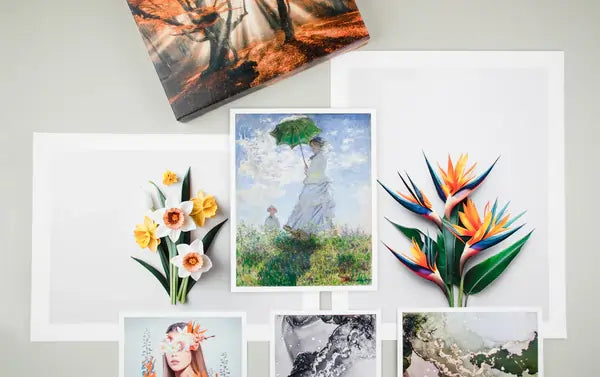In the printing world, the terms art print and art reproduction are often used interchangeably. While they have similar meanings and convey the same idea, these formats do have their differences. Understanding each concept is crucial when you want to make copies of your artwork to sell online or at events. Keep reading to learn everything you need to know about art prints versus art reproductions and what makes them different.
What Is an Art Print?
The term “print” can have a variety of meanings in the art industry. Print refers to a copy of a piece of artwork and how experts create it. For example, you may go to an art show and find an artist selling prints of their work. There are two main types of prints: original and fine art.
Original prints are typically part of a limited edition or series of artwork. There are many ways an artist can create these types of copies, such as using reliefs, stencils, lithographs, or methods like engraving. The artist usually handles the creation of an original print, which they then use to make copies of their work by stamping or inking high-quality paper. Because these prints are originals and part of a limited run, artists will sign them and mark them for authenticity.
Prints can also be referred to as art prints or fine art prints, which are digital copies of a work. These include digital copies of artwork or photographs that artists order or print themselves using high-quality paper and printers. Giclee prints are a popular type of high-quality fine art print; these can also be known as giclee reproductions.
What Is an Art Reproduction?
Art reproductions are images that artists or companies mass-produce through specific printing methods, such as giclee. Because printing companies often handle creating art reproductions, people usually label these products as prints, which is where some of the naming confusion comes from. While reproductions still depict the original work of artists, these copies don’t have the same quality and dimension as the original pieces. However, with high-quality printing methods, you can still achieve all the detail and texture of an original piece through different finishes, such as glossy paper or canvas board.
Reproductions are popular options for selling at art fairs and shows, conventions, and similar events. Some artists will still choose to sign reproductions, especially when selling or handing them out in person. Even when selling art online, signing your print reproductions allows you to add an individualized touch to these mass-produced pieces.
What Are the Differences Between Prints and Reproductions?
Print and reproduction both refer to copies of an original piece of artwork. Often, whether an artist chooses to make and sell prints or reproductions is up to their own preference.
The main difference between original prints and reproductions is how they are made. An artist can create carvings and stencils to stamp or ink prints by hand. Alternatively, digital printing equipment, such as giclee or inkjet printers, handles the creation of reproductions. This allows artists to mass produce them and create more copies in a short amount of time.
Price is another key factor that differentiates prints and reproductions. Original artwork and original prints often sell for much more than reproductions since the artist produces the latter in greater quantities. Original prints are handmade, which increases their value. Some printmaking methods can lead to flaws or printing errors, but many buyers see this as a value of their handmade quality and authenticity.
What Makes a Print Original?
Some confusion may come from referring to art prints as originals. Original artwork and original prints are not the same thing. Original works are the pieces artists create on paper, canvas, and other materials with a variety of art mediums. Original prints are the replications an artist makes through carving, stenciling, stamping, and other traditional printmaking techniques.
Why Would Artists Want To Create Prints or Reproductions?
Artists may create prints or reproductions to sell their artwork while holding onto the original piece. Not all artists have an audience or following that can pay hundreds or thousands of dollars for an original piece. In this instance, mass-producing reproductions is a great option for artists who are looking for ways to sell and share their work at a more affordable price point.
Artists who attend art shows or display their work in galleries could also be in need of prints or reproductions. Some museums even display prints of famous artworks to avoid exposing the original pieces to damaging conditions or the risk of theft.
Finally, some artists simply enjoy the printing process itself. The printmaking process can be extremely rewarding and relaxing to many artists. In fact, it can be just as enjoyable as the creation of the original art piece.
Which Method Should You Choose for Your Own Art?
If you’re interested in learning more about printmaking, consider finding a local course. Stock up on the materials you’ll need so you can practice the carving, stenciling, and stamping techniques at home. Learning how to make your own prints can be quite satisfying.
Alternatively, ordering art reproductions may be the best option for others. You might need a more hands-off approach and a way to produce more copies in a shorter amount of time. Also, you may want to create more affordable copies that anyone in your audience can purchase and enjoy.
Where Can You Order Your Own Art Reproductions?
If you’re interested in working with a printing company that offers high-quality fine art prints, check out our services at The Stackhouse. We produce stunning archival art prints with state-of-the-art giclee printers. If you need a large-scale print for an art show or gallery, our large-format custom printing services can supply you with gallery-quality prints when you need them. Browse our website for a list of services to see all the benefits of giclee printing.
It’s important to understand the differences between art prints and art reproductions, especially when planning how you’re going to create copies of your art for your audience. If you need reproductions or fine art prints before your next event, remember to check out our printing services at The Stackhouse. Our experts can help you select a printing style that beautifully highlights your work.






Leave a Comment